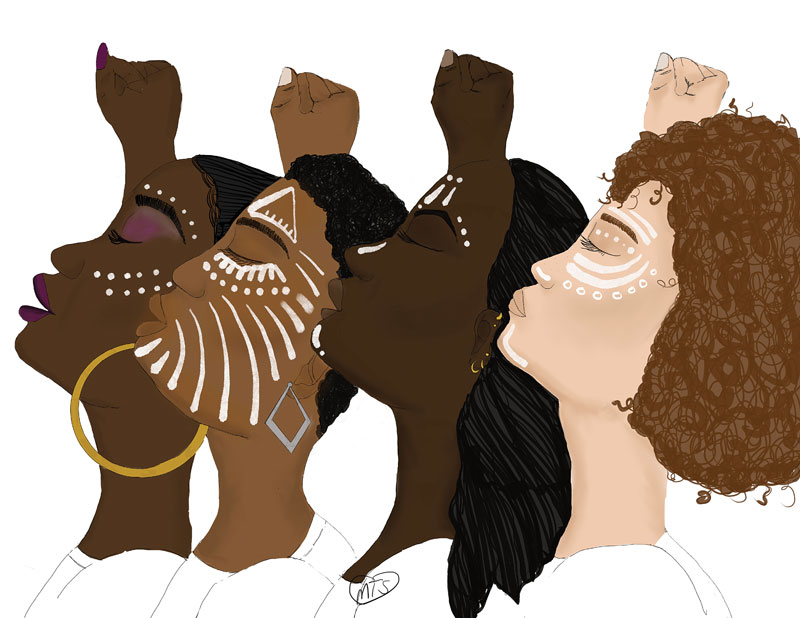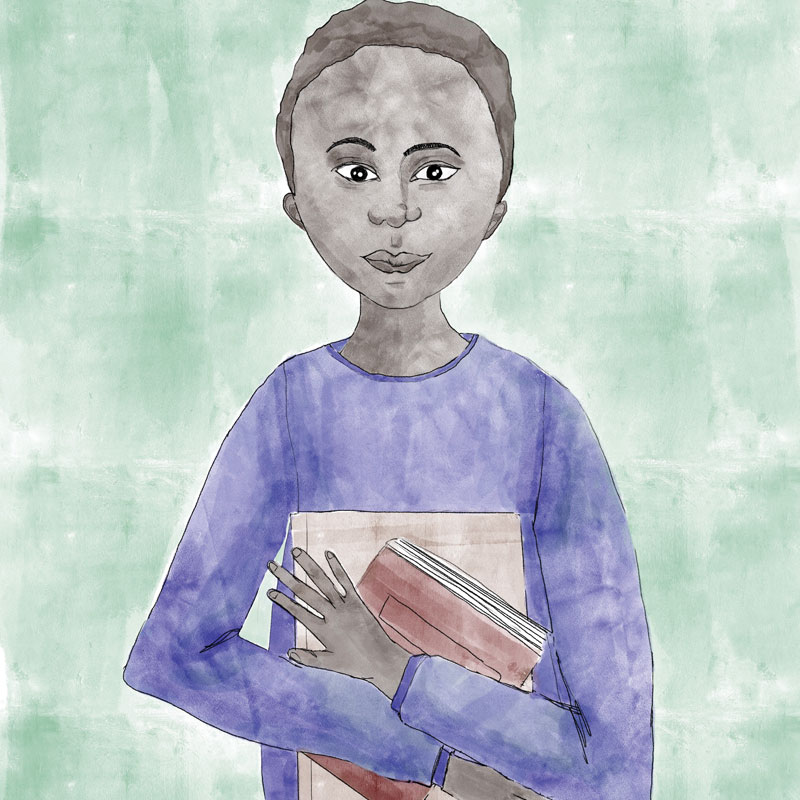
Click here to download this article as it appears in the magazine, with accompanying artwork.
This article comes from the Spring 2021 edition of the Nonprofit Quarterly, “Radical Leadership: Visioning Lines of Flight.”
“There’s this notion that change takes time. But in reality, a lot of change just happens in radical paradigm shifts,” explains Cyndi Suarez, Nonprofit Quarterly’s new president and editor in chief. “If you don’t know that process of transformation, then you don’t know how to harness it.”
In late-December 2020, Suarez was promoted from her role as senior editor, and kicked off 2021 by inviting the entire staff to a five-day virtual vision retreat.
Suarez says, and has demonstrated, that “a different person in leadership with a different set of assumptions can actually shift the system.” Since this leadership transition, Nonprofit Quarterly has refined the editorial line to sharpen its focus on analyzing justice as it pertains to race, the economy, climate, and health. This focus allows NPQ to delve into the ecosystems that comprise these issue areas, especially social movements, nonprofit organizations, and philanthropy. Suarez came to these frames as a result of various conversations with leaders over the past four years, in which the main theme was ecosystem sensemaking.
NPQ has also been restructured to support leading thinking and practice from the field—particularly from leaders of color—which has already been in development through Edge Leadership, an R+D platform for social change hosted by NPQ and launched by Suarez before taking on her new role. NPQ is currently building out a Voice Lab for leaders of color in the field interested in developing their voice. The lab will host writing, podcasting, online learning, and social media workshops; and it will support the development of a body of work through purpose, storytelling mediums, and audience workshops. This unique relationship between Edge Leadership, an environment set up to cultivate voice, and NPQ, a publication, creates the conditions for the knowledge creation needed now within and beyond the sector.
Joel Toner, president and publisher of the Nonprofit Quarterly, is thrilled by the organization’s progress. “We are so lucky to have Cyndi, as the organization is positioned to provide the critical racial equity and leadership perspectives our readers and the sector need right now.”
Suarez and Toner are working closely to strengthen and diversify NPQ’s revenue streams, including fortifying the organization’s grant support, growing its burgeoning membership model, and building out other earned revenue opportunities, including its highly successful online learning program.
Toner praises Suarez’s innovative leadership style, which he says is already transforming all aspects of NPQ’s mission and has quickly galvanized staff. “It creates a more vibrant, creative, energetic, woven organization, where good ideas come from everywhere and not just from the top but from every role in the organization and from everyone in the room,” he said.
Marcus Walton, president and CEO of Grantmakers for Effective Organizations, notes Suarez’s rare blend of imagining new ideas and operationalizing change. “Being able to use this platform to share a perspective that, quite frankly, has never been asked of me before, translated into an elevation of my status in the field.” Walton believes Suarez will lead NPQ to elevate the voices of those who go unheard. “Cyndi’s work, support, and encouragement to share my point of view at NPQ has translated into a level of credibility that could have taken years to achieve otherwise,” he said.
“What excites me most is innovation. I’m attracted to new ideas,” says Suarez, who has been involved in social change for thirty years as an organizer, strategist, funder, and intellectual. “Movements for social change need to create new ways of thinking and being. People who are not used to being seen as having power can take power and create new forms of social change.”
Walton calls Edge Leadership “next level”—the answer to the question, What is next? Advanced practitioners are being engaged on the platform to explore possibilities in ways Walton has not seen before. “Edge Leadership allows us to have a space to explore possibilities instead of negotiating through practical, constrained, preexisting options offered by current inequitable structures.”
Sign up for our free newsletters
Subscribe to NPQ's newsletters to have our top stories delivered directly to your inbox.
By signing up, you agree to our privacy policy and terms of use, and to receive messages from NPQ and our partners.
This idea that it is possible to create new forms, or ways of organizing life, is central to Suarez’s creative approach. Based on her field research with leaders of color, she has prioritized four pillars critical to creating new forms of civic infrastructure: vision, accountability, knowledge creation and evaluation, and space to replenish. “In essence, edge leaders are creating a new culture,” she says. “They are designing at the edge, between the present and a livable future.” Bit by bit, these ideas are making their way into NPQ via multimedia articles featuring voices from the field, and articles by edge leaders.
Christopher Cardona, program officer at Ford Foundation, marvels at Suarez’s ability to synthesize complex theory into digestible, applicable bites. “It’s a vision of power and mastery that people of color in particular can exercise in environments that are not designed for them, or environments that are even designed to oppress them and force them to not bring their full selves to what they’re doing. Cyndi offers a framework, a way of thinking and being and feeling that helps people in nonprofit organizations understand their own individual and collective power differently and exercise it from wherever they are.”
Cathy Garcia of Philanthropy Con Café calls Suarez’s work, particularly her series on Women of Color in Leadership and her book The Power Manual, “foundational.” “When I think of Cyndi’s leadership, I think of somebody who is not afraid to ask really deep, intentional questions. We especially need that in this sector that thrives on politeness and niceness at the expense of accountability and having real conversations.”
Suarez believes it is vital for leaders of color to be at the forefront of imagining the future for nonprofits and civil society. “There’re a lot of spaces for analyzing what’s wrong with the world we have now. But there are not a lot of spaces for imagining the world we want to live in,” she said.
She can’t pinpoint how she developed this point of view. But she remembers, as a teen, going to a feminist bookstore and asking for the section on Latina authors. The clerk pointed her to a tiny section of books, and Suarez remembers thinking, “Great. There’s space for me to write the books that need to be written.”
“People think theory is abstract,” Suarez says, “but for me it is real.” She describes herself as a “theory head from the hood,” and is known for breaking down complex ideas into relevant calls to action. Her recent piece “Forms: A New Theory of Power” describes ways in which we can rethink society.1 “What Does It Look Like to Support Women of Color to Lead,” written when political strategist and movement builder Wilnelia Rivera helped Ayanna Pressley to win a Congressional seat with the slogan “Change Can’t Wait,” continues to reverberate in nonprofit boardrooms, among philanthropy leaders, and across sectors.2 “This design beyond limits is challenging and even dangerous work that shifts not just what is made, but the maker,” says Suarez. “Very few people will take it on. However, it only takes a critical mass of sufficient energy to make a difference.” She describes the four pillars of this change noted earlier, in “Infrastructure for a New World,” in which she articulates infrastructure as “not just physical space or things, but the ability and capacity to be part of what we’re building.”
Suarez’s new podcast series features women of color.3 “I’m really interested in tracking women of color in power this year as part of our key work. Why does it matter for women of color to be in power? How do we do power differently?” Through candid, in-depth interviews, listeners will come to understand how these women embarked on their paths to leadership, how their leadership styles have evolved over the years, how they envision their work now, and what they hope to see for their fellow women-of-color leaders.
Suarez recalls how her thinking about power started early in life. “I remember as a kid when I started to realize that I had racial, gender, and class identities that positioned me as low status in society. But I didn’t think of myself as marginalized. In fact, I saw these as privileged positions for understanding power. It’s easier to see how power works from the bottom, even though it can be hard.”
Kristell Caballero Saucedo, program officer for Racial Equity Initiatives REP Fund at Borealis Philanthropy, notes how the sector gets stuck on criticism, and that Suarez manages to lead in a way that demands people to imagine and offer solutions: “You can play while doing this work. You can imagine. You can create. You can innovate.”
The Nonprofit Quarterly welcomes Suarez’s leadership and a new generation of effort to influence whose voice is heard, how to think creatively, and how to be a liberatory social change agent.
Notes
- Cyndi Suarez, “Forms: A New Theory of Power,” Nonprofit Quarterly, March 18, 2021.
- Cyndi Suarez, “What Does It Look Like to Support Women of Color to Lead?,” Nonprofit Quarterly, January 4, 2021.
- See first in series: Cyndi Suarez, “New Borealis Leader Outlines Bold Vision for Philanthropy,” Tiny Spark podcast, Nonprofit Quarterly, February 4, 2021.












